HLSC220: Colonisation's Impacts on First Peoples' Health Outcomes
VerifiedAdded on 2023/04/25
|10
|2664
|185
Essay
AI Summary
This essay critically analyzes the impact of colonisation on the health outcomes of Aboriginal and Torres Strait Islander people in Australia, focusing on two key policy eras: the Stolen Generation (1910-1970s) and the Northern Territory Emergency Response (2007). It examines the key themes within each policy, their contemporary impacts on health, and how historical determinants affect healthcare practices. The essay also discusses strength-based approaches that health practitioners can use to build trust and collaborative relationships with First Peoples, addressing issues such as the forced removal of children, educational disparities, and the influence of political and social environments on healthcare access and outcomes. The analysis highlights the need for culturally sensitive and empowering strategies to improve the health and well-being of Aboriginal and Torres Strait Islander communities.

Running head: IMPACTS OF COLONISATION ON THE FIRST PEOPLE OF
AUSTRALIA
Impacts of Colonisation on the First People of Australia
Name of the Student:
Name of the University:
Author note:
AUSTRALIA
Impacts of Colonisation on the First People of Australia
Name of the Student:
Name of the University:
Author note:
Paraphrase This Document
Need a fresh take? Get an instant paraphrase of this document with our AI Paraphraser

1IMPACTS OF COLONISATION ON THE FIRST PEOPLE OF AUSTRALIA
The aboriginals and the Torres islanders lived in the Australian continent for around
600 decades but the quality of life led by the same has degraded. The economic and social
poverty resulted to the crisis and negligence towards the people. On the other hand, Williams,
Ulm, Sapienza, Lewis and Turney (2018) stated that the lack of education among the
aboriginals also affected their health and livelihood. According to a survey by Heery,
Sheehan, While, and Coyne (2015) some 67% of the aboriginals are deprived of educational
and healthcare facilities computed on the year 2018. The purpose of undertaking the
discussion is to elaborate the impact of colonization on contemporary First Peoples’ health
outcomes. The research will also focus on discussing the different changes that might be
undertaken in the workplace in order to mitigate the issues that are b4eing faced by the
aboriginals and the Torres Islanders. The discussion will portray two policies and the manner
in which they affect the health and livelihood of the First people of America. Lastly, the
research will also delineate the different strength based approaches that are considered by a
health based practitioner while building the trust and collaborative relationship with the First
Peoples on an individual and community basis. The policies that will be considered during
the discussion are 1910-1970s Forced removal of children (Stolen generation) and the 2007
Northern Territory Emergency Response.
Key themes- The Stolen Generation existed in between the year 1910 and 1970 when
the Australian government took steps to move 1, 00,000 aboriginal children away from their
homes with the belief that they hold no future. Howard (2016) stated that the period of stolen
generation depended on the belief that the aboriginal children would prosper when they will
be transferred to the white families. The aboriginal children, mostly of 5 years age, were
taken away from their families and their parents were informed that the government took the
children for a vaccination programme. On the other hand, the rich white families were
provided with good sum of capital for taking care of the aboriginal children. During an
The aboriginals and the Torres islanders lived in the Australian continent for around
600 decades but the quality of life led by the same has degraded. The economic and social
poverty resulted to the crisis and negligence towards the people. On the other hand, Williams,
Ulm, Sapienza, Lewis and Turney (2018) stated that the lack of education among the
aboriginals also affected their health and livelihood. According to a survey by Heery,
Sheehan, While, and Coyne (2015) some 67% of the aboriginals are deprived of educational
and healthcare facilities computed on the year 2018. The purpose of undertaking the
discussion is to elaborate the impact of colonization on contemporary First Peoples’ health
outcomes. The research will also focus on discussing the different changes that might be
undertaken in the workplace in order to mitigate the issues that are b4eing faced by the
aboriginals and the Torres Islanders. The discussion will portray two policies and the manner
in which they affect the health and livelihood of the First people of America. Lastly, the
research will also delineate the different strength based approaches that are considered by a
health based practitioner while building the trust and collaborative relationship with the First
Peoples on an individual and community basis. The policies that will be considered during
the discussion are 1910-1970s Forced removal of children (Stolen generation) and the 2007
Northern Territory Emergency Response.
Key themes- The Stolen Generation existed in between the year 1910 and 1970 when
the Australian government took steps to move 1, 00,000 aboriginal children away from their
homes with the belief that they hold no future. Howard (2016) stated that the period of stolen
generation depended on the belief that the aboriginal children would prosper when they will
be transferred to the white families. The aboriginal children, mostly of 5 years age, were
taken away from their families and their parents were informed that the government took the
children for a vaccination programme. On the other hand, the rich white families were
provided with good sum of capital for taking care of the aboriginal children. During an
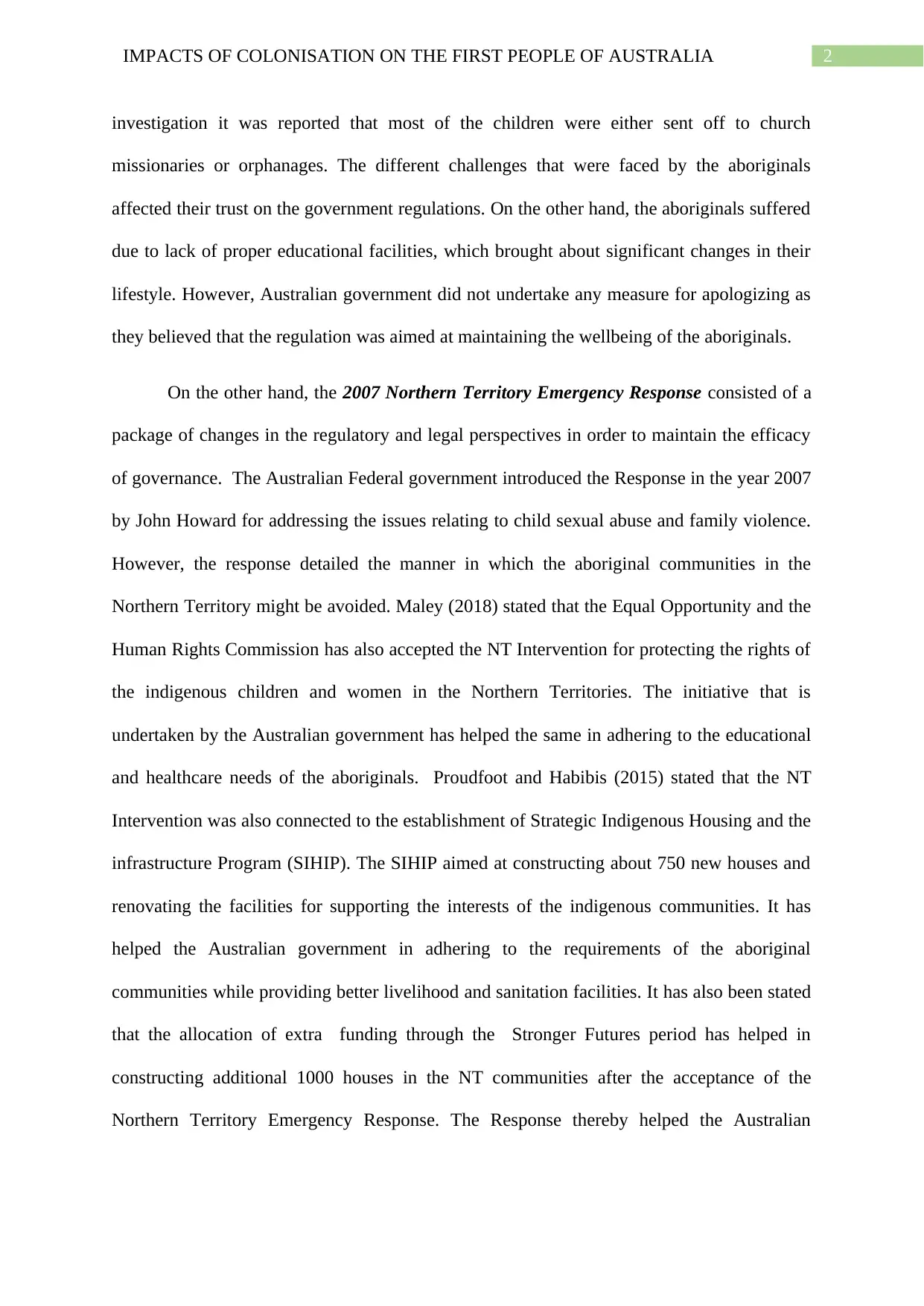
2IMPACTS OF COLONISATION ON THE FIRST PEOPLE OF AUSTRALIA
investigation it was reported that most of the children were either sent off to church
missionaries or orphanages. The different challenges that were faced by the aboriginals
affected their trust on the government regulations. On the other hand, the aboriginals suffered
due to lack of proper educational facilities, which brought about significant changes in their
lifestyle. However, Australian government did not undertake any measure for apologizing as
they believed that the regulation was aimed at maintaining the wellbeing of the aboriginals.
On the other hand, the 2007 Northern Territory Emergency Response consisted of a
package of changes in the regulatory and legal perspectives in order to maintain the efficacy
of governance. The Australian Federal government introduced the Response in the year 2007
by John Howard for addressing the issues relating to child sexual abuse and family violence.
However, the response detailed the manner in which the aboriginal communities in the
Northern Territory might be avoided. Maley (2018) stated that the Equal Opportunity and the
Human Rights Commission has also accepted the NT Intervention for protecting the rights of
the indigenous children and women in the Northern Territories. The initiative that is
undertaken by the Australian government has helped the same in adhering to the educational
and healthcare needs of the aboriginals. Proudfoot and Habibis (2015) stated that the NT
Intervention was also connected to the establishment of Strategic Indigenous Housing and the
infrastructure Program (SIHIP). The SIHIP aimed at constructing about 750 new houses and
renovating the facilities for supporting the interests of the indigenous communities. It has
helped the Australian government in adhering to the requirements of the aboriginal
communities while providing better livelihood and sanitation facilities. It has also been stated
that the allocation of extra funding through the Stronger Futures period has helped in
constructing additional 1000 houses in the NT communities after the acceptance of the
Northern Territory Emergency Response. The Response thereby helped the Australian
investigation it was reported that most of the children were either sent off to church
missionaries or orphanages. The different challenges that were faced by the aboriginals
affected their trust on the government regulations. On the other hand, the aboriginals suffered
due to lack of proper educational facilities, which brought about significant changes in their
lifestyle. However, Australian government did not undertake any measure for apologizing as
they believed that the regulation was aimed at maintaining the wellbeing of the aboriginals.
On the other hand, the 2007 Northern Territory Emergency Response consisted of a
package of changes in the regulatory and legal perspectives in order to maintain the efficacy
of governance. The Australian Federal government introduced the Response in the year 2007
by John Howard for addressing the issues relating to child sexual abuse and family violence.
However, the response detailed the manner in which the aboriginal communities in the
Northern Territory might be avoided. Maley (2018) stated that the Equal Opportunity and the
Human Rights Commission has also accepted the NT Intervention for protecting the rights of
the indigenous children and women in the Northern Territories. The initiative that is
undertaken by the Australian government has helped the same in adhering to the educational
and healthcare needs of the aboriginals. Proudfoot and Habibis (2015) stated that the NT
Intervention was also connected to the establishment of Strategic Indigenous Housing and the
infrastructure Program (SIHIP). The SIHIP aimed at constructing about 750 new houses and
renovating the facilities for supporting the interests of the indigenous communities. It has
helped the Australian government in adhering to the requirements of the aboriginal
communities while providing better livelihood and sanitation facilities. It has also been stated
that the allocation of extra funding through the Stronger Futures period has helped in
constructing additional 1000 houses in the NT communities after the acceptance of the
Northern Territory Emergency Response. The Response thereby helped the Australian
⊘ This is a preview!⊘
Do you want full access?
Subscribe today to unlock all pages.

Trusted by 1+ million students worldwide
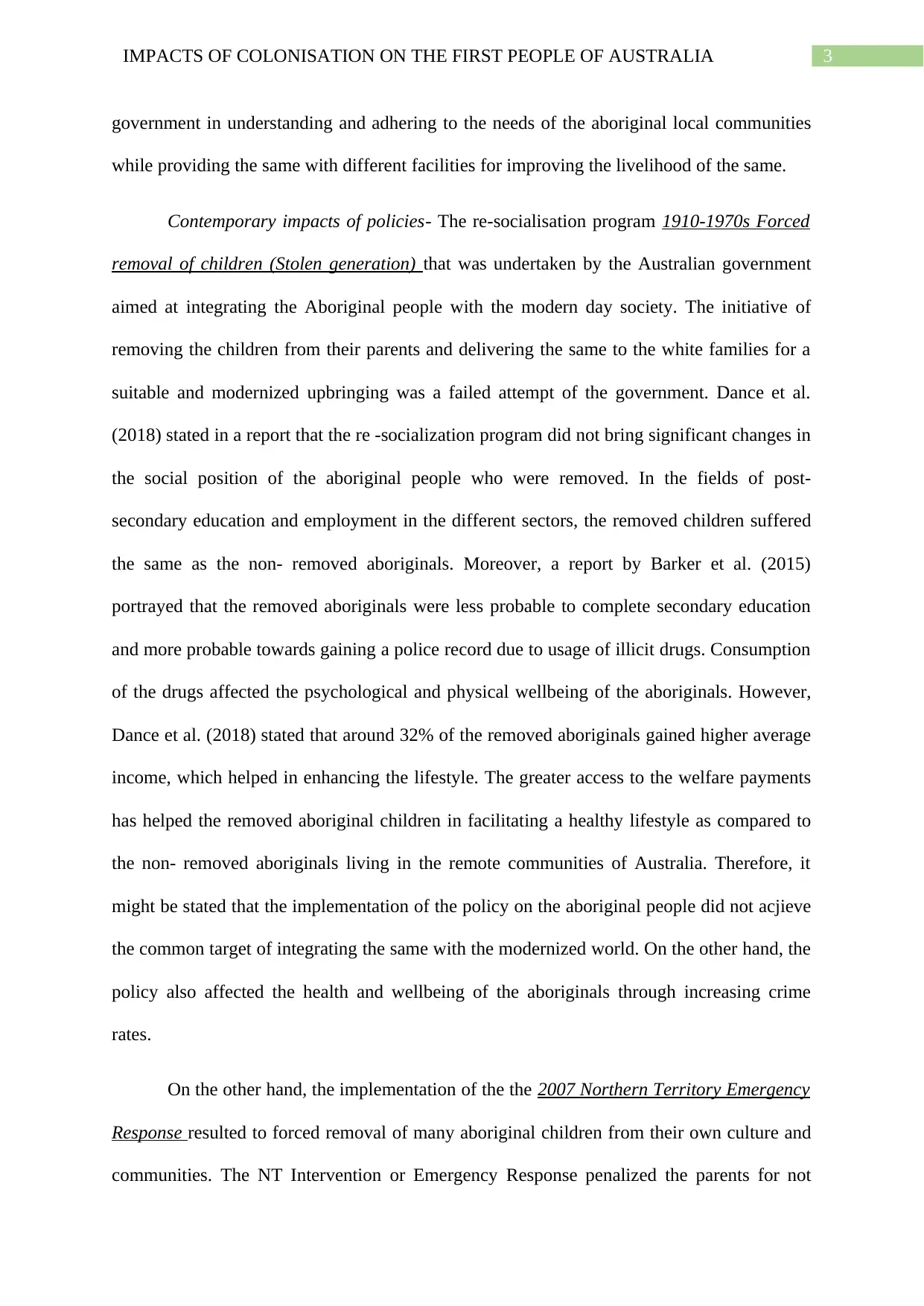
3IMPACTS OF COLONISATION ON THE FIRST PEOPLE OF AUSTRALIA
government in understanding and adhering to the needs of the aboriginal local communities
while providing the same with different facilities for improving the livelihood of the same.
Contemporary impacts of policies- The re-socialisation program 1910-1970s Forced
removal of children (Stolen generation) that was undertaken by the Australian government
aimed at integrating the Aboriginal people with the modern day society. The initiative of
removing the children from their parents and delivering the same to the white families for a
suitable and modernized upbringing was a failed attempt of the government. Dance et al.
(2018) stated in a report that the re -socialization program did not bring significant changes in
the social position of the aboriginal people who were removed. In the fields of post-
secondary education and employment in the different sectors, the removed children suffered
the same as the non- removed aboriginals. Moreover, a report by Barker et al. (2015)
portrayed that the removed aboriginals were less probable to complete secondary education
and more probable towards gaining a police record due to usage of illicit drugs. Consumption
of the drugs affected the psychological and physical wellbeing of the aboriginals. However,
Dance et al. (2018) stated that around 32% of the removed aboriginals gained higher average
income, which helped in enhancing the lifestyle. The greater access to the welfare payments
has helped the removed aboriginal children in facilitating a healthy lifestyle as compared to
the non- removed aboriginals living in the remote communities of Australia. Therefore, it
might be stated that the implementation of the policy on the aboriginal people did not acjieve
the common target of integrating the same with the modernized world. On the other hand, the
policy also affected the health and wellbeing of the aboriginals through increasing crime
rates.
On the other hand, the implementation of the the 2007 Northern Territory Emergency
Response resulted to forced removal of many aboriginal children from their own culture and
communities. The NT Intervention or Emergency Response penalized the parents for not
government in understanding and adhering to the needs of the aboriginal local communities
while providing the same with different facilities for improving the livelihood of the same.
Contemporary impacts of policies- The re-socialisation program 1910-1970s Forced
removal of children (Stolen generation) that was undertaken by the Australian government
aimed at integrating the Aboriginal people with the modern day society. The initiative of
removing the children from their parents and delivering the same to the white families for a
suitable and modernized upbringing was a failed attempt of the government. Dance et al.
(2018) stated in a report that the re -socialization program did not bring significant changes in
the social position of the aboriginal people who were removed. In the fields of post-
secondary education and employment in the different sectors, the removed children suffered
the same as the non- removed aboriginals. Moreover, a report by Barker et al. (2015)
portrayed that the removed aboriginals were less probable to complete secondary education
and more probable towards gaining a police record due to usage of illicit drugs. Consumption
of the drugs affected the psychological and physical wellbeing of the aboriginals. However,
Dance et al. (2018) stated that around 32% of the removed aboriginals gained higher average
income, which helped in enhancing the lifestyle. The greater access to the welfare payments
has helped the removed aboriginal children in facilitating a healthy lifestyle as compared to
the non- removed aboriginals living in the remote communities of Australia. Therefore, it
might be stated that the implementation of the policy on the aboriginal people did not acjieve
the common target of integrating the same with the modernized world. On the other hand, the
policy also affected the health and wellbeing of the aboriginals through increasing crime
rates.
On the other hand, the implementation of the the 2007 Northern Territory Emergency
Response resulted to forced removal of many aboriginal children from their own culture and
communities. The NT Intervention or Emergency Response penalized the parents for not
Paraphrase This Document
Need a fresh take? Get an instant paraphrase of this document with our AI Paraphraser
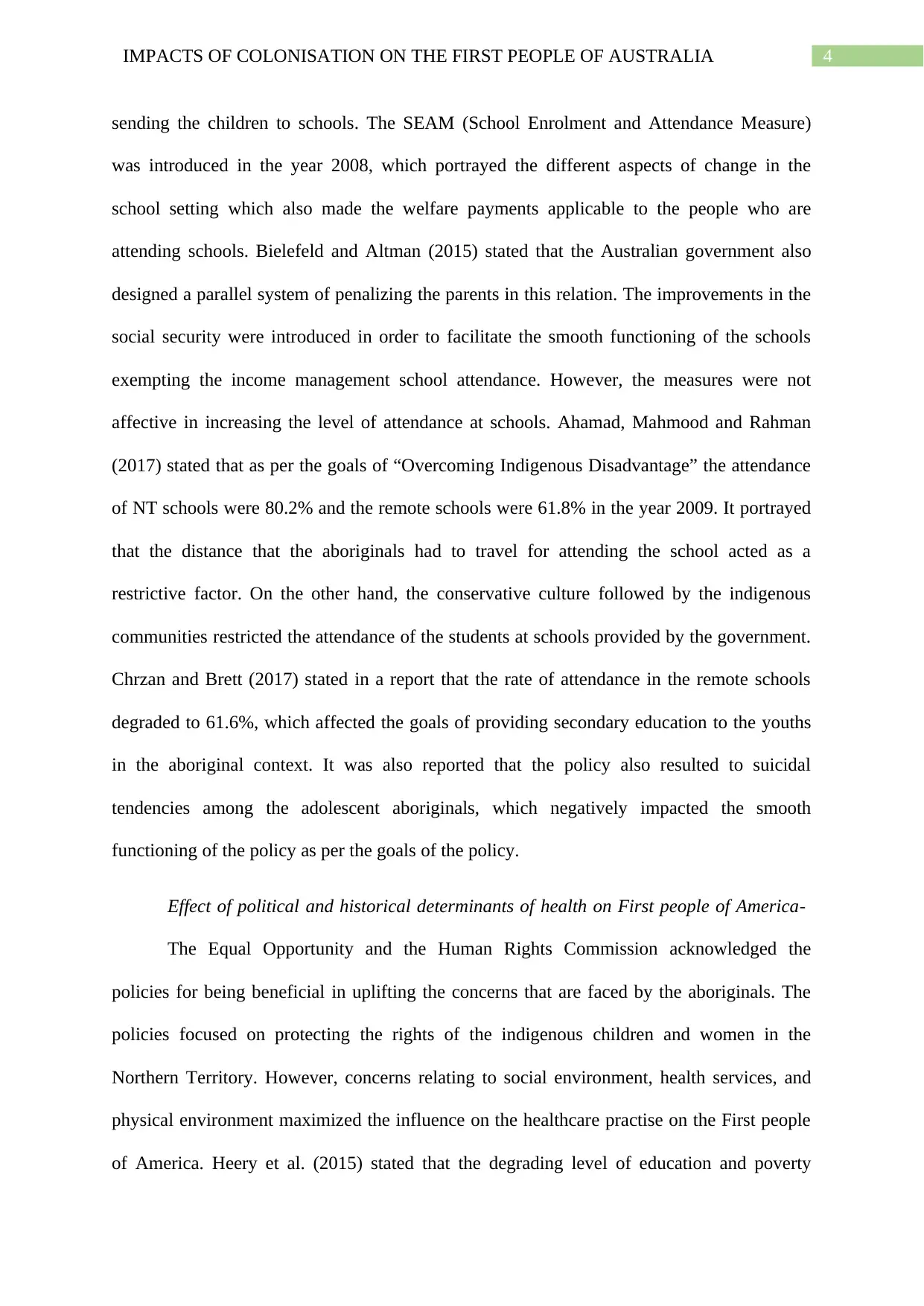
4IMPACTS OF COLONISATION ON THE FIRST PEOPLE OF AUSTRALIA
sending the children to schools. The SEAM (School Enrolment and Attendance Measure)
was introduced in the year 2008, which portrayed the different aspects of change in the
school setting which also made the welfare payments applicable to the people who are
attending schools. Bielefeld and Altman (2015) stated that the Australian government also
designed a parallel system of penalizing the parents in this relation. The improvements in the
social security were introduced in order to facilitate the smooth functioning of the schools
exempting the income management school attendance. However, the measures were not
affective in increasing the level of attendance at schools. Ahamad, Mahmood and Rahman
(2017) stated that as per the goals of “Overcoming Indigenous Disadvantage” the attendance
of NT schools were 80.2% and the remote schools were 61.8% in the year 2009. It portrayed
that the distance that the aboriginals had to travel for attending the school acted as a
restrictive factor. On the other hand, the conservative culture followed by the indigenous
communities restricted the attendance of the students at schools provided by the government.
Chrzan and Brett (2017) stated in a report that the rate of attendance in the remote schools
degraded to 61.6%, which affected the goals of providing secondary education to the youths
in the aboriginal context. It was also reported that the policy also resulted to suicidal
tendencies among the adolescent aboriginals, which negatively impacted the smooth
functioning of the policy as per the goals of the policy.
Effect of political and historical determinants of health on First people of America-
The Equal Opportunity and the Human Rights Commission acknowledged the
policies for being beneficial in uplifting the concerns that are faced by the aboriginals. The
policies focused on protecting the rights of the indigenous children and women in the
Northern Territory. However, concerns relating to social environment, health services, and
physical environment maximized the influence on the healthcare practise on the First people
of America. Heery et al. (2015) stated that the degrading level of education and poverty
sending the children to schools. The SEAM (School Enrolment and Attendance Measure)
was introduced in the year 2008, which portrayed the different aspects of change in the
school setting which also made the welfare payments applicable to the people who are
attending schools. Bielefeld and Altman (2015) stated that the Australian government also
designed a parallel system of penalizing the parents in this relation. The improvements in the
social security were introduced in order to facilitate the smooth functioning of the schools
exempting the income management school attendance. However, the measures were not
affective in increasing the level of attendance at schools. Ahamad, Mahmood and Rahman
(2017) stated that as per the goals of “Overcoming Indigenous Disadvantage” the attendance
of NT schools were 80.2% and the remote schools were 61.8% in the year 2009. It portrayed
that the distance that the aboriginals had to travel for attending the school acted as a
restrictive factor. On the other hand, the conservative culture followed by the indigenous
communities restricted the attendance of the students at schools provided by the government.
Chrzan and Brett (2017) stated in a report that the rate of attendance in the remote schools
degraded to 61.6%, which affected the goals of providing secondary education to the youths
in the aboriginal context. It was also reported that the policy also resulted to suicidal
tendencies among the adolescent aboriginals, which negatively impacted the smooth
functioning of the policy as per the goals of the policy.
Effect of political and historical determinants of health on First people of America-
The Equal Opportunity and the Human Rights Commission acknowledged the
policies for being beneficial in uplifting the concerns that are faced by the aboriginals. The
policies focused on protecting the rights of the indigenous children and women in the
Northern Territory. However, concerns relating to social environment, health services, and
physical environment maximized the influence on the healthcare practise on the First people
of America. Heery et al. (2015) stated that the degrading level of education and poverty
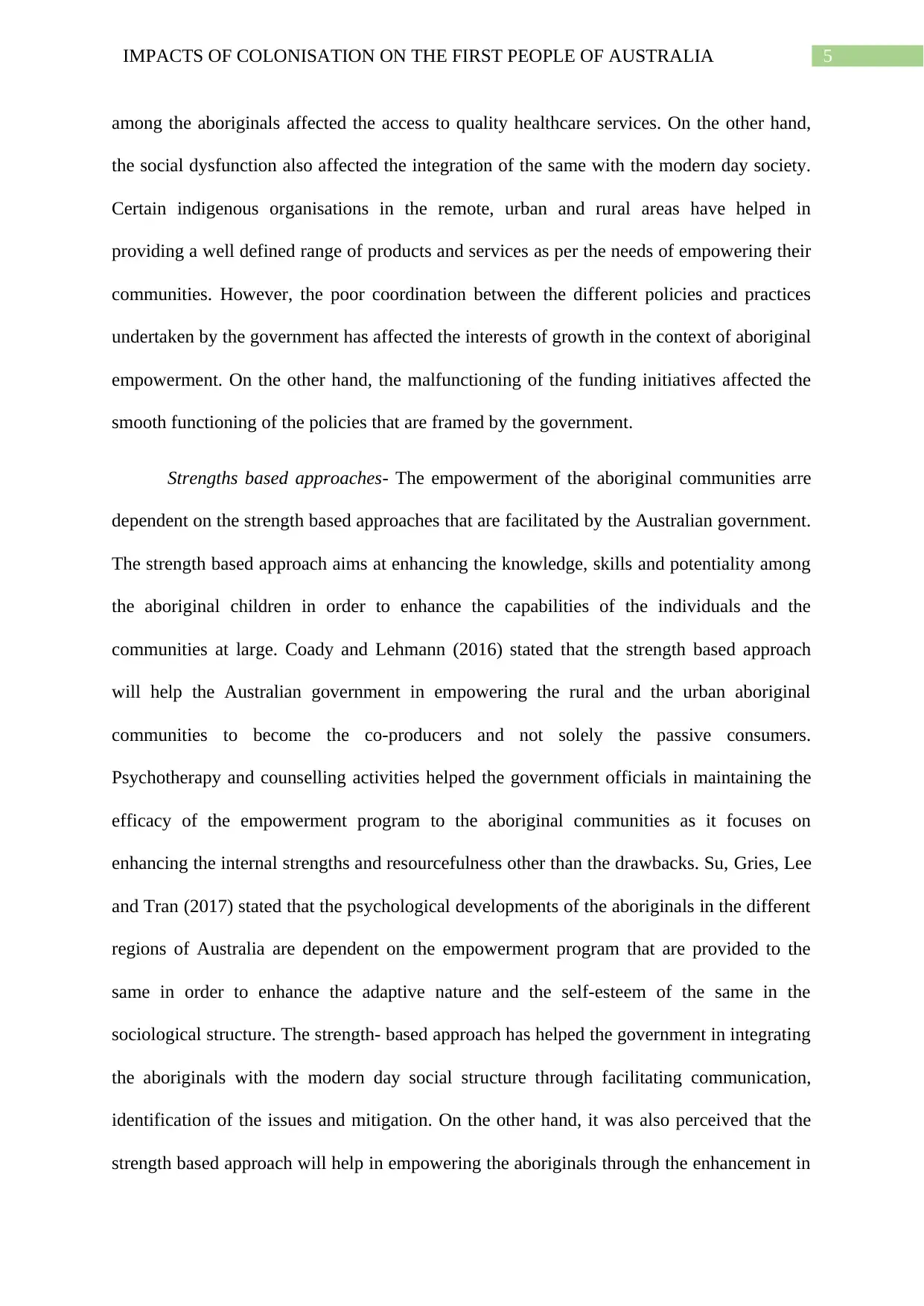
5IMPACTS OF COLONISATION ON THE FIRST PEOPLE OF AUSTRALIA
among the aboriginals affected the access to quality healthcare services. On the other hand,
the social dysfunction also affected the integration of the same with the modern day society.
Certain indigenous organisations in the remote, urban and rural areas have helped in
providing a well defined range of products and services as per the needs of empowering their
communities. However, the poor coordination between the different policies and practices
undertaken by the government has affected the interests of growth in the context of aboriginal
empowerment. On the other hand, the malfunctioning of the funding initiatives affected the
smooth functioning of the policies that are framed by the government.
Strengths based approaches- The empowerment of the aboriginal communities arre
dependent on the strength based approaches that are facilitated by the Australian government.
The strength based approach aims at enhancing the knowledge, skills and potentiality among
the aboriginal children in order to enhance the capabilities of the individuals and the
communities at large. Coady and Lehmann (2016) stated that the strength based approach
will help the Australian government in empowering the rural and the urban aboriginal
communities to become the co-producers and not solely the passive consumers.
Psychotherapy and counselling activities helped the government officials in maintaining the
efficacy of the empowerment program to the aboriginal communities as it focuses on
enhancing the internal strengths and resourcefulness other than the drawbacks. Su, Gries, Lee
and Tran (2017) stated that the psychological developments of the aboriginals in the different
regions of Australia are dependent on the empowerment program that are provided to the
same in order to enhance the adaptive nature and the self-esteem of the same in the
sociological structure. The strength- based approach has helped the government in integrating
the aboriginals with the modern day social structure through facilitating communication,
identification of the issues and mitigation. On the other hand, it was also perceived that the
strength based approach will help in empowering the aboriginals through the enhancement in
among the aboriginals affected the access to quality healthcare services. On the other hand,
the social dysfunction also affected the integration of the same with the modern day society.
Certain indigenous organisations in the remote, urban and rural areas have helped in
providing a well defined range of products and services as per the needs of empowering their
communities. However, the poor coordination between the different policies and practices
undertaken by the government has affected the interests of growth in the context of aboriginal
empowerment. On the other hand, the malfunctioning of the funding initiatives affected the
smooth functioning of the policies that are framed by the government.
Strengths based approaches- The empowerment of the aboriginal communities arre
dependent on the strength based approaches that are facilitated by the Australian government.
The strength based approach aims at enhancing the knowledge, skills and potentiality among
the aboriginal children in order to enhance the capabilities of the individuals and the
communities at large. Coady and Lehmann (2016) stated that the strength based approach
will help the Australian government in empowering the rural and the urban aboriginal
communities to become the co-producers and not solely the passive consumers.
Psychotherapy and counselling activities helped the government officials in maintaining the
efficacy of the empowerment program to the aboriginal communities as it focuses on
enhancing the internal strengths and resourcefulness other than the drawbacks. Su, Gries, Lee
and Tran (2017) stated that the psychological developments of the aboriginals in the different
regions of Australia are dependent on the empowerment program that are provided to the
same in order to enhance the adaptive nature and the self-esteem of the same in the
sociological structure. The strength- based approach has helped the government in integrating
the aboriginals with the modern day social structure through facilitating communication,
identification of the issues and mitigation. On the other hand, it was also perceived that the
strength based approach will help in empowering the aboriginals through the enhancement in
⊘ This is a preview!⊘
Do you want full access?
Subscribe today to unlock all pages.

Trusted by 1+ million students worldwide

6IMPACTS OF COLONISATION ON THE FIRST PEOPLE OF AUSTRALIA
the self esteem. The practitioner recognizes the in- built skills of the aboriginal people and
thereby providing the same with confidence through retelling the people of their past history.
The induction of positive thinking will be helping the practitioner in inducing confidence
among the aboriginals while understanding the issues that are faced by the same.
Therefore, from the above analysis it might be stated that the different policies that
are introduced by the Australian government helped in empowering the aboriginal
communities through re- socialization and self-determination. On the other hand, the
allocation of resources for improving the educational and healthcare facilities helped the
government in maintaining the efficacy of the operations as per the needs of the aboriginals.
the self esteem. The practitioner recognizes the in- built skills of the aboriginal people and
thereby providing the same with confidence through retelling the people of their past history.
The induction of positive thinking will be helping the practitioner in inducing confidence
among the aboriginals while understanding the issues that are faced by the same.
Therefore, from the above analysis it might be stated that the different policies that
are introduced by the Australian government helped in empowering the aboriginal
communities through re- socialization and self-determination. On the other hand, the
allocation of resources for improving the educational and healthcare facilities helped the
government in maintaining the efficacy of the operations as per the needs of the aboriginals.
Paraphrase This Document
Need a fresh take? Get an instant paraphrase of this document with our AI Paraphraser

7IMPACTS OF COLONISATION ON THE FIRST PEOPLE OF AUSTRALIA
References:
Ahamed, A. S., Mahmood, N. T., & Rahman, R. M. (2017). An intelligent system to predict
academic performance based on different factors during adolescence. Journal of
Information and Telecommunication, 1(2), 155-175. Retrieved from:
https://www.tandfonline.com/doi/full/10.1080/24751839.2017.1323488
Barker, B., Alfred, G. T., Fleming, K., Nguyen, P., Wood, E., Kerr, T., &DeBeck, K. (2015).
Aboriginal street-involved youth experience elevated risk of incarceration. Public
health, 129(12), 1662-1668. Retrieved from: https://exchange.youthrex.com/research-
summary/aboriginal-street-involved-youth-experience-elevated-risk-incarceration
Bielefeld, S., & Altman, J. (2015). Australia's First Peoples–Still Struggling for Protection
Against Racial Discrimination. Retrieved from: https://research-
repository.griffith.edu.au/bitstream/handle/10072/379596/BielefeldPUB3305.pdf?
sequence=1
Chrzan, J., & Brett, J. (Eds.). (2017). Research Methods for Anthropological Studies of Food
and Nutrition (Vol. 1). Berghahn Books. Retrieved from:
https://www.berghahnbooks.com/series/Research-Methods-for-Anthropological-
Studies-of-Food-and-Nutrition
Coady, N., & Lehmann, P. (Eds.). (2016). Theoretical perspectives for direct social work
practice: A generalist-eclectic approach. Springer Publishing Company. Retrieved
from:
http://lghttp.48653.nexcesscdn.net/80223CF/springer-static/media/samplechapters/
9780826119476/9780826119476_chapter.pdf
Dance, P., Guthrie, J., McDonald, D., D'Souza, R., Cubillo, C., Bammer, G., & Tongs, J.
(2018). " I want to be heard": an analysis of needs of Aboriginal and Torres Strait
References:
Ahamed, A. S., Mahmood, N. T., & Rahman, R. M. (2017). An intelligent system to predict
academic performance based on different factors during adolescence. Journal of
Information and Telecommunication, 1(2), 155-175. Retrieved from:
https://www.tandfonline.com/doi/full/10.1080/24751839.2017.1323488
Barker, B., Alfred, G. T., Fleming, K., Nguyen, P., Wood, E., Kerr, T., &DeBeck, K. (2015).
Aboriginal street-involved youth experience elevated risk of incarceration. Public
health, 129(12), 1662-1668. Retrieved from: https://exchange.youthrex.com/research-
summary/aboriginal-street-involved-youth-experience-elevated-risk-incarceration
Bielefeld, S., & Altman, J. (2015). Australia's First Peoples–Still Struggling for Protection
Against Racial Discrimination. Retrieved from: https://research-
repository.griffith.edu.au/bitstream/handle/10072/379596/BielefeldPUB3305.pdf?
sequence=1
Chrzan, J., & Brett, J. (Eds.). (2017). Research Methods for Anthropological Studies of Food
and Nutrition (Vol. 1). Berghahn Books. Retrieved from:
https://www.berghahnbooks.com/series/Research-Methods-for-Anthropological-
Studies-of-Food-and-Nutrition
Coady, N., & Lehmann, P. (Eds.). (2016). Theoretical perspectives for direct social work
practice: A generalist-eclectic approach. Springer Publishing Company. Retrieved
from:
http://lghttp.48653.nexcesscdn.net/80223CF/springer-static/media/samplechapters/
9780826119476/9780826119476_chapter.pdf
Dance, P., Guthrie, J., McDonald, D., D'Souza, R., Cubillo, C., Bammer, G., & Tongs, J.
(2018). " I want to be heard": an analysis of needs of Aboriginal and Torres Strait
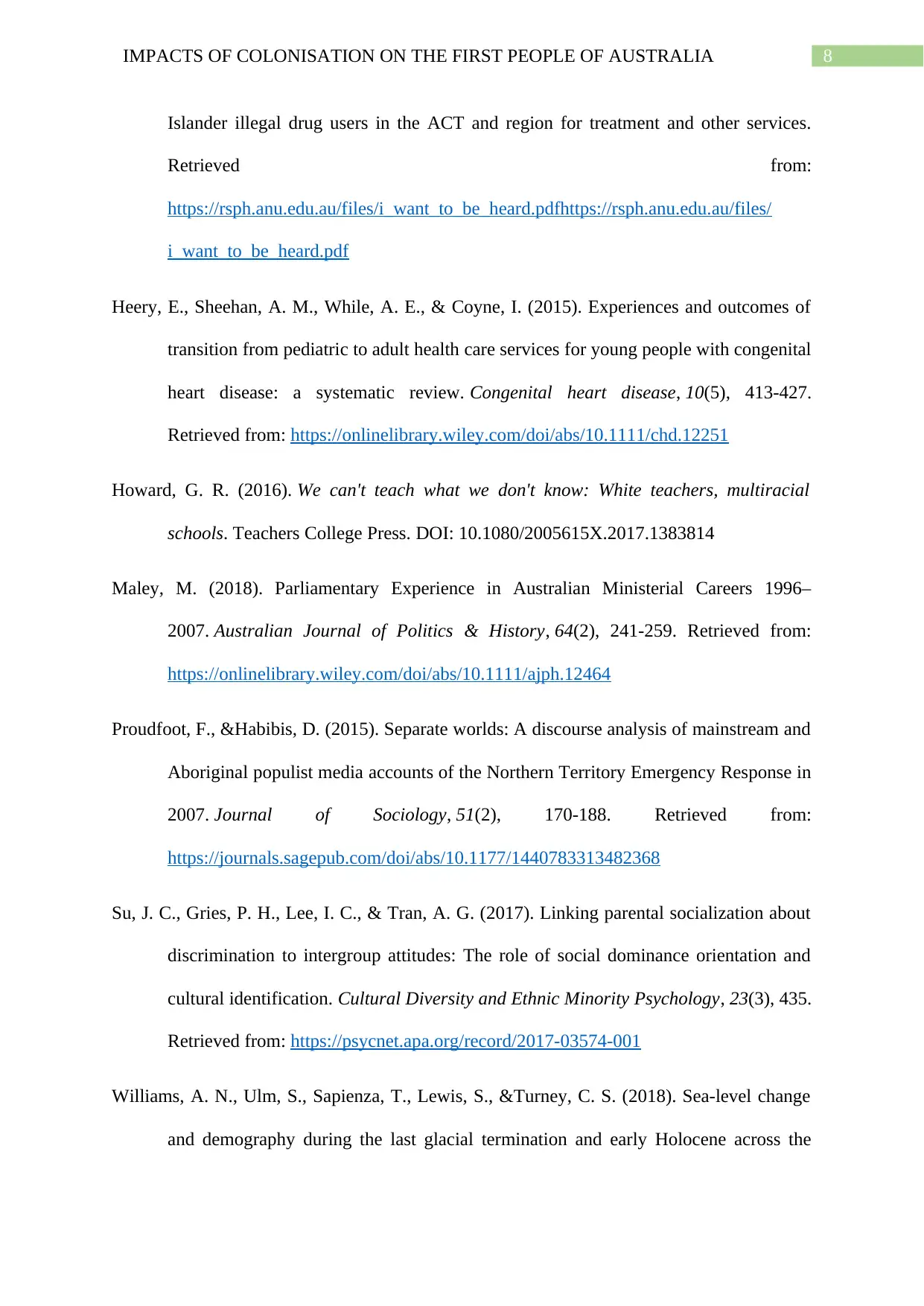
8IMPACTS OF COLONISATION ON THE FIRST PEOPLE OF AUSTRALIA
Islander illegal drug users in the ACT and region for treatment and other services.
Retrieved from:
https://rsph.anu.edu.au/files/i_want_to_be_heard.pdfhttps://rsph.anu.edu.au/files/
i_want_to_be_heard.pdf
Heery, E., Sheehan, A. M., While, A. E., & Coyne, I. (2015). Experiences and outcomes of
transition from pediatric to adult health care services for young people with congenital
heart disease: a systematic review. Congenital heart disease, 10(5), 413-427.
Retrieved from: https://onlinelibrary.wiley.com/doi/abs/10.1111/chd.12251
Howard, G. R. (2016). We can't teach what we don't know: White teachers, multiracial
schools. Teachers College Press. DOI: 10.1080/2005615X.2017.1383814
Maley, M. (2018). Parliamentary Experience in Australian Ministerial Careers 1996–
2007. Australian Journal of Politics & History, 64(2), 241-259. Retrieved from:
https://onlinelibrary.wiley.com/doi/abs/10.1111/ajph.12464
Proudfoot, F., &Habibis, D. (2015). Separate worlds: A discourse analysis of mainstream and
Aboriginal populist media accounts of the Northern Territory Emergency Response in
2007. Journal of Sociology, 51(2), 170-188. Retrieved from:
https://journals.sagepub.com/doi/abs/10.1177/1440783313482368
Su, J. C., Gries, P. H., Lee, I. C., & Tran, A. G. (2017). Linking parental socialization about
discrimination to intergroup attitudes: The role of social dominance orientation and
cultural identification. Cultural Diversity and Ethnic Minority Psychology, 23(3), 435.
Retrieved from: https://psycnet.apa.org/record/2017-03574-001
Williams, A. N., Ulm, S., Sapienza, T., Lewis, S., &Turney, C. S. (2018). Sea-level change
and demography during the last glacial termination and early Holocene across the
Islander illegal drug users in the ACT and region for treatment and other services.
Retrieved from:
https://rsph.anu.edu.au/files/i_want_to_be_heard.pdfhttps://rsph.anu.edu.au/files/
i_want_to_be_heard.pdf
Heery, E., Sheehan, A. M., While, A. E., & Coyne, I. (2015). Experiences and outcomes of
transition from pediatric to adult health care services for young people with congenital
heart disease: a systematic review. Congenital heart disease, 10(5), 413-427.
Retrieved from: https://onlinelibrary.wiley.com/doi/abs/10.1111/chd.12251
Howard, G. R. (2016). We can't teach what we don't know: White teachers, multiracial
schools. Teachers College Press. DOI: 10.1080/2005615X.2017.1383814
Maley, M. (2018). Parliamentary Experience in Australian Ministerial Careers 1996–
2007. Australian Journal of Politics & History, 64(2), 241-259. Retrieved from:
https://onlinelibrary.wiley.com/doi/abs/10.1111/ajph.12464
Proudfoot, F., &Habibis, D. (2015). Separate worlds: A discourse analysis of mainstream and
Aboriginal populist media accounts of the Northern Territory Emergency Response in
2007. Journal of Sociology, 51(2), 170-188. Retrieved from:
https://journals.sagepub.com/doi/abs/10.1177/1440783313482368
Su, J. C., Gries, P. H., Lee, I. C., & Tran, A. G. (2017). Linking parental socialization about
discrimination to intergroup attitudes: The role of social dominance orientation and
cultural identification. Cultural Diversity and Ethnic Minority Psychology, 23(3), 435.
Retrieved from: https://psycnet.apa.org/record/2017-03574-001
Williams, A. N., Ulm, S., Sapienza, T., Lewis, S., &Turney, C. S. (2018). Sea-level change
and demography during the last glacial termination and early Holocene across the
⊘ This is a preview!⊘
Do you want full access?
Subscribe today to unlock all pages.

Trusted by 1+ million students worldwide

9IMPACTS OF COLONISATION ON THE FIRST PEOPLE OF AUSTRALIA
Australian continent. Quaternary Science Reviews, 182, 144-154. Retrieved from:
https://api.research-repository.uwa.edu.au/portalfiles/portal/34709043/Full_text.pdf
Australian continent. Quaternary Science Reviews, 182, 144-154. Retrieved from:
https://api.research-repository.uwa.edu.au/portalfiles/portal/34709043/Full_text.pdf
1 out of 10
Related Documents
Your All-in-One AI-Powered Toolkit for Academic Success.
+13062052269
info@desklib.com
Available 24*7 on WhatsApp / Email
![[object Object]](/_next/static/media/star-bottom.7253800d.svg)
Unlock your academic potential
Copyright © 2020–2025 A2Z Services. All Rights Reserved. Developed and managed by ZUCOL.




